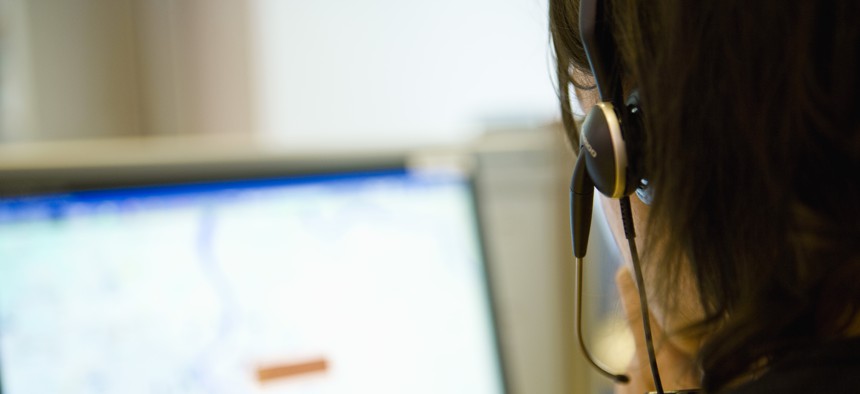Survey: More than three-fourths of 911 centers face staffing crisis

PhotoAlto/James Hardy via Getty Images

Connecting state and local government leaders
While not enough research has been done to identify and address issues dispatchers are facing, a recent poll shows 911 centers are understaffed and overwhelmed by calls.
In a finding described as “quite startling,” only 44% of 911 dispatchers in a new survey reported feeling trained well enough to handle all types of calls that come into the emergency number.
The percentage decreased with the size of the call center: Only 39% of dispatchers in mid-sized centers, with between 11-30 workers, said that they've been adequately trained to deal with all kinds of crises. That confidence waned even more when polled on a specific incident: More than one-third, or 38% of dispatchers surveyed at 307 call centers around the country, said they haven’t had enough training to handle active shooter situations.
The survey comes as there is little research on the profession and the issues workers are facing, says Brian Fontes, CEO of the National Emergency Number Association, a nonprofit that develops standards and provides training at 911 centers around the country. His group partnered with Carbyne, a company that creates 911 technology, to conduct the survey.
“We are one of the industries that have had a lack of very good, solid research regarding the profession,” he said during a conference earlier this week to discuss the findings of the study.
In addition to inadequate training, the study found that 911 call centers like other parts of state and local governments, are struggling to find and retain workers. A “staggering” 82% percent of the dispatchers and managers polled said their call centers are understaffed. More than one-third said they have half as many workers as they need. And 13 of the centers said 71% of their positions are vacant.
Half of the understaffed centers surveyed also said that they get flooded with calls every day, and 84% said they get hit with a barrage of calls multiple times every week. Making things even worse, the study said that more people are calling 911 by accident. The number of misdials dispatchers are getting has “increased exponentially with the growing use of smartphones, smart devices and apps that include easily-triggered emergency call buttons,” the report said.
This is all contributing to burnout among dispatchers. While 88% said they feel positive about working at a 911 center, 70% said they suffer from fatigue, 56% deal with anxiety and 53% feel unenergetic. About 80% said the stress and pay made it difficult to attract new workers.
“The number of young people joining is not nearly enough to replace the number not only retiring but also those burning out,” the survey said.
Ninety percent of the respondents said their call centers offer support in dealing with the stresses of the job, including an Employee Assistance Program. But only 34% of employees said they use the services.
“It may be a time factor. It may be, ‘Gee, I don't want to share my need for help,’” said Fontes. “We need to have a very open and frank discussion about the importance of our own mental health and wellness and the things that we can do to improve that.”
One sign of hope, however, is that new technologies being developed could help ease the load on workers, according to several 911 operations managers at the conference.
In the survey, dispatchers were divided on whether technology will help. But Brad Flanagan, the emergency operations manager for Pitkin County, Colorado, near Aspen, said it could help manage an influx of duplicative calls.
“You get a crash at a location in your jurisdiction,” he said, “and you've got 1,000 people calling in. How many of those calls can we realistically take?”
Instead, those calls could be sent to a chatbot that would ask, “Hey, are you calling about this crash? If yes, Are you involved in the crash? If not, tell me what you saw,” Flanagan said.
The information is then entered into the call center’s system. Those who are calling about a different incident in the accident would be sent to a dispatcher for help. “None of us are trying to replace our staff with bots,” he said. “What we're trying to do is give them breathing room.”
Jeff Hannon, the 911 dispatch supervisor in Guernsey County, Ohio, said the ability of passersby to send videos of incidents could also save call centers and first responders time.
For example, he said, it can take ambulances 40 minutes to get to a scene of an accident in the rural county. How technology helps, he said, is if someone reports an accident to 911 and says, “‘There's fuel leaking everywhere. There's smoke pouring out of it.’ We turn on the camera and it happens to just be radiator fluid. That's going to save us from sending a fire department to that call. It’s very important to our center to be able to look and see and diagnose.”
Kery Murakami is a senior reporter for Route Fifty, covering Congress and federal policy. He can be reached at kmurakami@govexec.com. Follow @Kery_Murakami

NEXT STORY: Helping young people make a quantum leap





